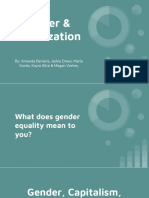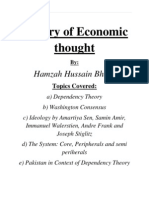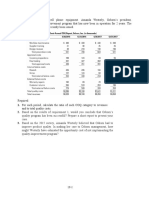Women in Development
Women in Development
Uploaded by
Zain Ul AbideenCopyright:
Available Formats
Women in Development
Women in Development
Uploaded by
Zain Ul AbideenOriginal Title
Copyright
Available Formats
Share this document
Did you find this document useful?
Is this content inappropriate?
Copyright:
Available Formats
Women in Development
Women in Development
Uploaded by
Zain Ul AbideenCopyright:
Available Formats
Women in development (WID) approach, was originated as a result of three major feminist moments/waves
concerning feminine conditions. The first two were due to the feminist waves. The first wave also known as women’s
suffrage movement, originated in the North America back in the late 19th century, when women fought for the equal
right to vote and participate in politics. The second-wave of feminism sought to deal with the remaining social and
cultural inequalities women were faced with in everyday affair i.e. sexual violence, reproductive rights, sexual
discrimination and glass ceilings. The second wave was very controversial however the women’s movement was very
influential that the UN organized the first global conference on women back in 1975 at Mexico. The conference
sought to address nations role on fighting gender inequalities and support women’s right. The third was influenced by
Ester Boserup (1970) publication on “Women’s Role in Economic Development”. “The book sent a shock wave
through northern development agencies and humanitarian organization” (pg 93). She states and gave empirical
results of how increasingly specialized division of labor associated with development undermines or neglects the
value of women’s work and status especially in the developing world. As it explains why women were being deprived
an equal share among men in social benefits and economic gains. Boserup book had an influence on making women
more visible in development approach and as a specific category when addressing women in development. In 1973,
the US congress implemented a bill, which required the USAID to include women in development programs. The WID
approach helped to ensure, the integration of women into the workforce and increase their level of productivity in
order to improve their lives. However some have criticized this approach as being very western. Since it is a
perception of the global south from global north perspective, as it fails to acknowledge the collective and cultural
concerns of women in the developing world. It approach has been tagged as being rather cumbersome on women, as
it fails to understand the dynamics of the private sphere but focus solely on the public sphere.
The women and development (WAD) approach originated back in 1975 in Mexico city, as it sort to discuss women’s
issues from a neo-Marxist and dependency theory perspective. Its focus was to “explain the relationship between
women and the process of capitalist development in terms of material conditions that contribute to their exploitation”
(pg 95). WAD is often misinterpreted as WID, however what sets it apart is that, WAD focuses specifically on the
relation between patriarchy and capitalism. The WAD perspective states that women have always participated and
contributed towards economic development, regardless of the public or private spheres.
The Gender and development approach originated in the 1980s by socialist feminism. It serve as a transitioning point
in the way in which feminist have understood development. It served as a comprehensive overview of the social,
economic and political realities of development. It origin relates back to the Development Alternatives with Women for
a New Era (DAWN) network, when it was first initiated in India. The DAWN program was then officially recognized in
1986 during the 3rd UN conference on women in Nairobi. The conference brought about activist, researcher and
development practitioners globally. As the conference discussed about the achievements made from the previous
decade’s evaluation of promoting equality among the sexes, and a full scope of the obstacles limiting women’s
advancements, especially in the developing world. The forum discussed about the effectiveness of the continuous
debt crisis and structural adjustment program implemented by the IMF and the World Bank, and how such concept of
neoliberalism tend to marginalize and discriminate women more in the developing countries. The diversity of this
approach was open to the experiences and need of women in the developing world. Its two main goals were to prove
that the unequal relationship between the sexes hinders development and female participation. The second, it sort to
change the structure of power into a long-term goal whereby all decision-making and benefits of development are
distributed on equal basis of gender neutrality. The GAD approach is not just focused on the biological inequalities
among sexes: men and women, however on how social roles, reproductive roles and economic roles are linked to
Gender inequalities of: masculinity and femininity
You might also like
- Wid Wad Gad Approaches To Women EmpowermentDocument7 pagesWid Wad Gad Approaches To Women EmpowermentChristian Kusema Jr.100% (1)
- Women in DevelopmentDocument5 pagesWomen in DevelopmentKhunsha Agha KhanNo ratings yet
- Gender Equality and Women Representation in GovernanceDocument16 pagesGender Equality and Women Representation in GovernanceAbasiNo ratings yet
- Gender Studies Lecture 2Document18 pagesGender Studies Lecture 2anon_116484471No ratings yet
- Masculinity or FemininityDocument8 pagesMasculinity or FemininityZulfiqar KlairNo ratings yet
- Women Empowerment: Essay No. 3Document5 pagesWomen Empowerment: Essay No. 3Krishna Abhilash0% (1)
- Gender and GlobalizationDocument5 pagesGender and Globalizationbebs CachoNo ratings yet
- Women Universities As Agents of ChangeDocument7 pagesWomen Universities As Agents of ChangeHisham TanvirNo ratings yet
- Gender InequalityDocument8 pagesGender InequalityAdnan HaiderNo ratings yet
- Gender InequalityDocument2 pagesGender InequalityIness KhattabiNo ratings yet
- Women in PakistanDocument7 pagesWomen in PakistanSyed Zulqarnain100% (3)
- Assignment On Participation of Women in PoliticsDocument13 pagesAssignment On Participation of Women in Politicsসুমন আহমেদ100% (2)
- Ethnicity and National IntegrationDocument18 pagesEthnicity and National IntegrationirfanullahNo ratings yet
- Autonmy Vs Integration and Gender Vs Women StudiesDocument18 pagesAutonmy Vs Integration and Gender Vs Women StudiesshujahkianiNo ratings yet
- Sociology of DevelopmentDocument5 pagesSociology of DevelopmentJhapaul LlaneraNo ratings yet
- Women Empowerment Through Five Year Plans in India: International Journal of Advanced Educational ResearchDocument4 pagesWomen Empowerment Through Five Year Plans in India: International Journal of Advanced Educational ResearchPranay Pandey100% (1)
- Poverty CSSDocument7 pagesPoverty CSSsohailbabarNo ratings yet
- Feminist Theory in SociologyDocument8 pagesFeminist Theory in SociologyLilibeth SolisNo ratings yet
- Mukhtar MaiDocument36 pagesMukhtar MaimahNo ratings yet
- Status of Gender Studies in Pakistan. 1Document6 pagesStatus of Gender Studies in Pakistan. 1ziad ullahNo ratings yet
- Introduction To Gender StudiesDocument4 pagesIntroduction To Gender StudiesBushra ShakeelNo ratings yet
- Lesson 38 - Media & Democracy in PakistanDocument12 pagesLesson 38 - Media & Democracy in PakistanKashif ImranNo ratings yet
- Unit 6 Wid-Wad-Gad - Part I StructureDocument34 pagesUnit 6 Wid-Wad-Gad - Part I StructureJojames GaddiNo ratings yet
- Problematizing The Category of "Sex" Queer Theory - CSS Gender Studies NotesDocument8 pagesProblematizing The Category of "Sex" Queer Theory - CSS Gender Studies NotesAwais BhattiNo ratings yet
- Wid Wad GadDocument1 pageWid Wad Gadaisha waheed100% (1)
- SOCIETYDocument21 pagesSOCIETYDennis RaymundoNo ratings yet
- An Introduction To Gender Studies Power Point NotesDocument49 pagesAn Introduction To Gender Studies Power Point NotesKudakwashe RuzvidzoNo ratings yet
- Gender and GovernanceDocument18 pagesGender and GovernanceJan muhammadNo ratings yet
- Brief History of Gender Studies, Gender in Different Areas of Study & Importance of Gender in DevelopmentDocument3 pagesBrief History of Gender Studies, Gender in Different Areas of Study & Importance of Gender in DevelopmentKoushik MahmudNo ratings yet
- A Study On Issues and Challenges of Women Empowerment in IndiaDocument7 pagesA Study On Issues and Challenges of Women Empowerment in IndiaJilson JosephNo ratings yet
- History of SOcial COnstructionismDocument6 pagesHistory of SOcial COnstructionismZarnish HussainNo ratings yet
- Gender & GlobalizationDocument25 pagesGender & GlobalizationMaria GordoNo ratings yet
- Gender Studies Notes by Shoib MemonDocument62 pagesGender Studies Notes by Shoib MemonZahid HussainNo ratings yet
- Sarah LongweDocument13 pagesSarah Longwedememorir100% (3)
- Basic Concepts in Gender StudiesDocument31 pagesBasic Concepts in Gender StudiesBere ChekwasNo ratings yet
- Feudal System in PakistanDocument3 pagesFeudal System in PakistanZia Ud Din100% (1)
- Status of Women in PakistanDocument2 pagesStatus of Women in Pakistanaati89No ratings yet
- Women in Development ApproachDocument20 pagesWomen in Development ApproachAnjali TuladharNo ratings yet
- Dependency Theory and PakistanDocument30 pagesDependency Theory and PakistanHamzah Bhatti71% (7)
- 3 Political CultureDocument22 pages3 Political CultureElena VoinovanNo ratings yet
- Q 10 Feminist Movements in Pakistan (PR)Document8 pagesQ 10 Feminist Movements in Pakistan (PR)Hassan Khan100% (1)
- Political DevelopmentDocument29 pagesPolitical Developmentizhar ahmad100% (1)
- Foreign Aid Blessing or CurseDocument25 pagesForeign Aid Blessing or CursePrashanth PatilNo ratings yet
- LECTURE 3 Feminist Movement in PakistanDocument3 pagesLECTURE 3 Feminist Movement in Pakistankamran kamiNo ratings yet
- Causes of Poverty in PakistanDocument3 pagesCauses of Poverty in PakistanAbid MughalNo ratings yet
- Multidisciplinary Nature of Gender Studies - PDF - Gender - Gender StudiesDocument22 pagesMultidisciplinary Nature of Gender Studies - PDF - Gender - Gender StudiesASMA RIAZNo ratings yet
- Civil Services Academy, Lahore Pakistan Administrative Campus 36 STPDocument44 pagesCivil Services Academy, Lahore Pakistan Administrative Campus 36 STPWajeha LatifNo ratings yet
- Past Papers Analysis: Current Affairs: Internal IssuesDocument3 pagesPast Papers Analysis: Current Affairs: Internal IssuesSalman Ali Bhutto100% (1)
- Role of Civil Society Orgn in GovernanceDocument45 pagesRole of Civil Society Orgn in GovernanceNorman BarnacheaNo ratings yet
- SociologyDocument14 pagesSociologyGhulam muhammad100% (1)
- Gender Stereotypes - Chapter 1Document16 pagesGender Stereotypes - Chapter 1Sanidad DonafilerwinNo ratings yet
- Women Participation in Indian Electoral SystemDocument4 pagesWomen Participation in Indian Electoral SystemVivek KumarNo ratings yet
- Globalization - Concept PaperDocument6 pagesGlobalization - Concept PaperBeatrice EdictoNo ratings yet
- UNICEF Gender Policy 2010Document16 pagesUNICEF Gender Policy 2010Nur Liyana MustaphaNo ratings yet
- Module 3 Gender and DevelopmentDocument16 pagesModule 3 Gender and DevelopmentDannyelle Sorreda100% (2)
- ICEP CSS - PMS Institute, Lahore (MCQ'S Gender Studies)Document22 pagesICEP CSS - PMS Institute, Lahore (MCQ'S Gender Studies)Majid Ameer AttariNo ratings yet
- Addressing Gender Inequalities to Build Resilience: Stocktaking of Good Practices in the Food and Agriculture Organization of the United Nations’ Strategic Objective 5From EverandAddressing Gender Inequalities to Build Resilience: Stocktaking of Good Practices in the Food and Agriculture Organization of the United Nations’ Strategic Objective 5No ratings yet
- Social Change and Development in PakistanFrom EverandSocial Change and Development in PakistanRating: 4.5 out of 5 stars4.5/5 (2)
- Us History NotesDocument32 pagesUs History NotesZain Ul AbideenNo ratings yet
- What Is Feminism?Document2 pagesWhat Is Feminism?Zain Ul AbideenNo ratings yet
- History of USA 2000Document38 pagesHistory of USA 2000Zain Ul AbideenNo ratings yet
- History - of - USA - Docx Version 1Document39 pagesHistory - of - USA - Docx Version 1Zain Ul AbideenNo ratings yet
- Tourism Industry in PakistanDocument7 pagesTourism Industry in PakistanZain Ul AbideenNo ratings yet
- Power:: Ability To Influence Something ElseDocument5 pagesPower:: Ability To Influence Something ElseZain Ul AbideenNo ratings yet
- 470 e 210 Community Organisation PracticeDocument95 pages470 e 210 Community Organisation PracticeNithin SindheNo ratings yet
- Case Study: JaspersoftDocument3 pagesCase Study: Jaspersofteduluz1976No ratings yet
- Narrative Text Concept MapDocument2 pagesNarrative Text Concept MapScribdTranslationsNo ratings yet
- FINAL INTERVIEW GUIDE For PSO V2Document1 pageFINAL INTERVIEW GUIDE For PSO V2ivygrace gabestpaelmaoNo ratings yet
- BUS 5910 - Unit 3 Discussion Assignment 5Document4 pagesBUS 5910 - Unit 3 Discussion Assignment 5Roshan SMECNo ratings yet
- Chavez vs. Presidential Commission On Good Government 299 SCRA 744, December 09, 1998Document38 pagesChavez vs. Presidential Commission On Good Government 299 SCRA 744, December 09, 1998Ralph Henry MagdalitaNo ratings yet
- Hair ShaftDocument10 pagesHair Shaftdevashish chouhanNo ratings yet
- Weebly 3science Fpd-Feathers Fur or LeavesDocument1 pageWeebly 3science Fpd-Feathers Fur or Leavesapi-361589918No ratings yet
- Bangalore CFA June 2012 1st BatchDocument2 pagesBangalore CFA June 2012 1st BatchkvarsityNo ratings yet
- Explainer Video Script TemplateDocument2 pagesExplainer Video Script TemplatenileshNo ratings yet
- Project: Title: Location: Design of Flywing at Median Wall PortionDocument2 pagesProject: Title: Location: Design of Flywing at Median Wall PortionRAMPRASADNo ratings yet
- WASH FIT Assessment Tool Master 27 Feb 2022Document150 pagesWASH FIT Assessment Tool Master 27 Feb 2022staffdev jprizalNo ratings yet
- Ramco Aviation - The Global Presence in AviationDocument11 pagesRamco Aviation - The Global Presence in AviationRamco SystemsNo ratings yet
- Norman Rockwell's Urban ConnectionDocument3 pagesNorman Rockwell's Urban ConnectionJane Allen PetrickNo ratings yet
- Capsicum Technical Bulletin To Iihr Web SiteDocument36 pagesCapsicum Technical Bulletin To Iihr Web SitemazharulnazimNo ratings yet
- Catering Alfabet NewDocument4 pagesCatering Alfabet NewCynthia SetiawanSNo ratings yet
- Case Analysis WalMart3Document6 pagesCase Analysis WalMart3Pei Wing GanNo ratings yet
- Article XDocument3 pagesArticle XKylie July100% (1)
- WATG Free Patterns Booklet Letter SizeDocument14 pagesWATG Free Patterns Booklet Letter SizeizzydrNo ratings yet
- 821G 921G 2018 Service Manual 51428267-Linked PDFDocument2,935 pages821G 921G 2018 Service Manual 51428267-Linked PDFFrancisco100% (2)
- Hyaline CartilageDocument1 pageHyaline CartilageKumar ThapaNo ratings yet
- Champions League 2024 ScheduleDocument1 pageChampions League 2024 Scheduleapi-499214664No ratings yet
- Quarter 3 Weekly Lesson Log in MathematicsDocument2 pagesQuarter 3 Weekly Lesson Log in MathematicsJano DeGuzmanNo ratings yet
- Video and Abstract Expressionism: Hermine FreedDocument10 pagesVideo and Abstract Expressionism: Hermine Freeddonkey slapNo ratings yet
- For Each Period, Calculate The Ratio of Each COQ Category To RevenuesDocument2 pagesFor Each Period, Calculate The Ratio of Each COQ Category To RevenuesElliot RichardNo ratings yet
- Dry Hand Sanitizer Dispensing MachineDocument7 pagesDry Hand Sanitizer Dispensing MachineVIVA-TECH IJRINo ratings yet
- C&M StandardGears PDFDocument13 pagesC&M StandardGears PDFlitonNo ratings yet
- Virginia Henderson's Need Based Theory and Practice ImplicationsDocument30 pagesVirginia Henderson's Need Based Theory and Practice ImplicationsSadia NadeemNo ratings yet
- Baldovino Yuannel Roaehr D. Activity 2Document2 pagesBaldovino Yuannel Roaehr D. Activity 2Ricardo Lorenzo AlasNo ratings yet
- A11. FO - Cao.00030-001 ICAO Annex I Check ListDocument8 pagesA11. FO - Cao.00030-001 ICAO Annex I Check ListsebastienNo ratings yet































































































